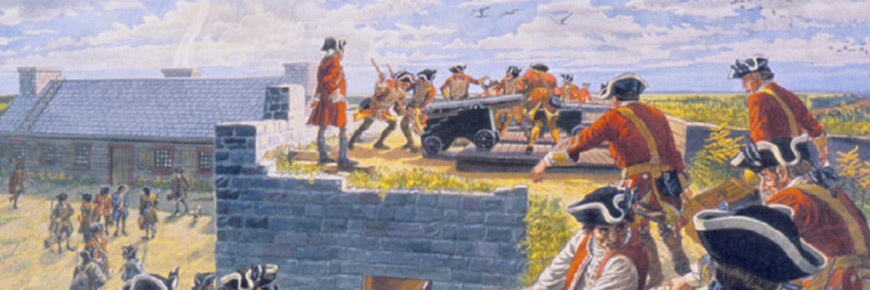
The 1776 siege of Fort Cumberland
Fort Beauséjour – Fort Cumberland National Historic Site
At the outbreak of the American Revolution in 1775, it was uncertain which side Nova Scotia would take. New Englanders formed the majority of the population, there were too few British troops to enforce loyalty, and not a single naval ship was assigned to the Nova Scotia station.
It was believed that many colonists favoured the American cause, and some local patriots actually were members of the legislature at Halifax. On the other hand, the New England settlers had been in the province for well over a decade, and local politics had diverged considerably from the radical New England mainstream.
Colonel Eddy's offensive
The uncertainty continued until the autumn of 1776, when a bold attempt was made by a small band of American patriots and local sympathizers to "add another stripe to the American flag", as their leader Colonel Jonathan Eddy said. Eddy, a former British army officer and a resident of the area, planned to capture the strategically located Fort Cumberland, then use that victory to incite a province-wide rebellion.
With approval of the American Congress and support from Massachusetts, Eddy collected "about twenty" Americans and entered Nova Scotia where he recruited local patriots at Maugerville, Cumberland and Cobequid, and in Acadian communities and the Native nations.
With an irregular force of about 180 men Colonel Eddy besieged Fort Cumberland in late October 1776. The fort was defended by about the same number of soldiers of the Royal Fencible Americans, a provincial regiment under the command of Colonel Joseph Goreham.
They had been there only since June and were poorly trained and equipped. The fort was run down, having been previously vacant for eight years. Repairs to the fortifications were carried out with the help of Yorkshire carpenters and workmen who were among the first to offer their services.
A month-long siege
Several unsuccessful attempts were made to force Goreham's surrender during the month-long siege that ensued. Friends of the fort managed to escape and make their way to Halifax with news of Eddy's attack. A relief force of forty Royal Marines was organized which sailed to Cumberland on the warship Vulture.
Arrival of the Vulture enabled Commander Goreham to prepare an attack on patriot headquarters at nearby Camphill. On November 27 a combined force of Royal Fencibles and Marines commanded by Major Thomas Batt marched out of the fort and assaulted Camphill.
Eddy and his men were promptly defeated. A few were captured and many more surrendered in the days following. The rest fled westward to the St. John river and eventually to the United States.
A hard winter
Several loyalist homes had been burned by Eddy's patriots, so it was not surprising that when the siege was lifted the homes of local patriots, and those of several Acadians, were burned in revenge.
The result was hardship that winter and civil tension that lasted for a generation. The successful British defence of Fort Cumberland shaped the attitudes of Nova Scotians to the American revolution and to their place in the North American world.
Next part: Changes to the fort after the second siegeRelated links
- Long before the Fort: Acadian settlement
- First warfare
- Zone of contention, place of growth
- The construction of a fort at Beauséjour
- Life inside the Fort during the French regime
- The Acadians and the fort
- Tensions of the 1750s
- The siege of 1755
- The deportation of the Acadians
- The start of the British occupation
- Settlers from Yorkshire
- Changes to the fort after the second siege
- Creation of the national historic site
- Archeological digs
- Date modified :